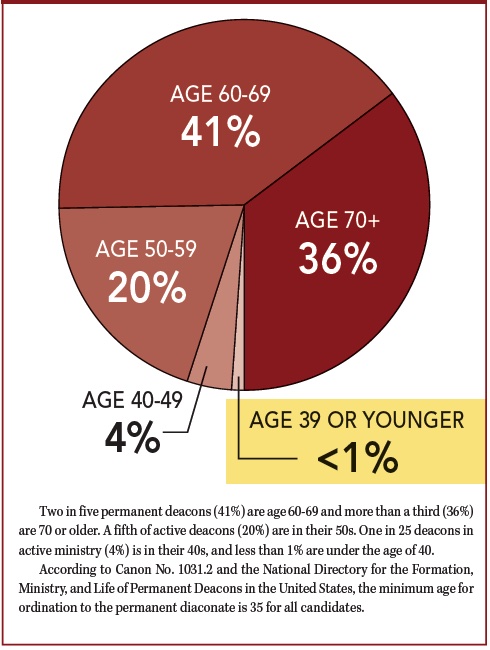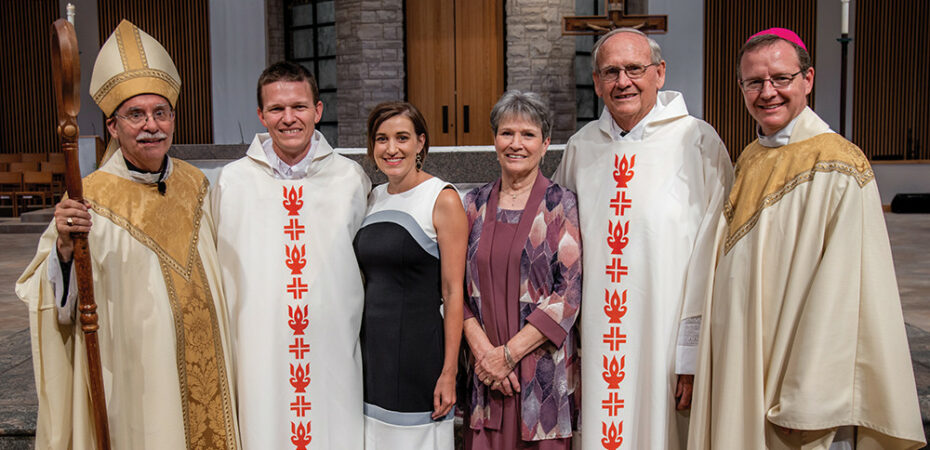Brothers in Ministry
As we look at the aging diaconate, our task is to facilitate listening to God’s voice
Deacon William T. Ditewig Comments Off on Brothers in Ministry
The subject of the age of deacons has been a subject of interest for decades. Most recently the annual study conducted by CARA (the Center for Applied Research in the Apostolate) on the diaconate highlighted the growing concern that annual ordinations of deacons are insufficient to offset annual retirements and deaths of deacons. Specifically, in 2021, approximately 458 new deacons were ordained, while 512 deacons retired from active ministry and another 393 died. As is the case with priests in the United States, there are not enough new permanent deacons being ordained to make up for the numbers who are retiring from active ministry and dying each year. While this may seem startling, it is something that has been a constant concern from the beginning of the renewal of the diaconate. In this brief article, we will contrast these most recent data with some historical data, and then suggest some steps we might take moving forward to reverse this trend.
Background
The “age” of deacons was already a point of concern during the Second Vatican Council. As the text of Lumen Gentium was developing during the second and third sessions of Vatican II, the background discussions by the bishops indicated a desire that married deacons be ordained at the age of 40 or older. St. Pope John Paul II participated in those discussions and would recall later in a general audience address: “A deeply felt need in the decision to reestablish the permanent diaconate was and is that of a greater and more direct presence of Church ministers in the various spheres of the family, work, school, etc., in addition to existing pastoral structures.”
The vision of the conciliar bishops was clear: They desired a diaconate not limited to “existing pastoral structures” like the parish, for example. Rather, they saw deacons, already and still working and living in the secular world, who would bring the sacred ministry of the Church to those venues. That’s not to say deacons should not be active in parish ministry. After all, John Paul II is careful to say that deacons are needed in new venues, “in addition to” existing structures. Therefore, as the bishops continued these discussions, they settled on a policy establishing the age of ordination for married deacons to be 35, and unmarried deacons to be 25. In short, they lowered the age of ordination. When the diaconate was restored in the United States in 1968, the bishops decided to use 35 for both married and unmarried “permanent” deacons. This remains the practice here, but to my knowledge, nowhere else in the world.
Contributing Factors
When I wrote “The Emerging Diaconate” (Paulist Press, $24.95) back in 2007, I was still serving at the USCCB and made use of the 2007 data collected by CARA. That data reported that the average age of deacons was 62; the 2022 data do not report an average age but do reveal that 77% of deacons are aged 60 or older. Thirty-six percent of deacons are over 70. Only 4% are aged 40-50, and less than 1% are under 40. This stands in stark contrast with the vision of Vatican II, which lowered the ordination age for deacons from 40 to 35!
So, how did this happen? There are several common reasons, all well-intentioned.
1) Bishops are concerned about the health of families, and therefore often establish diocesan policies that exclude applicants under a certain age. One bishop many years ago would not accept applicants who still had children living at home. Another bishop told me that he wanted no applicants under the age of 50. He went even further to say that this included unmarried applicants, because if they were single and under 50, he would want to suggest the seminary and priesthood.
2) Some younger potential applicants are rightly concerned about the time commitments for formation and eventually ordained ministry, especially with ever-expanding formation requirements.
3) Some deacons and priests actively discourage potential applicants. “You still have a young family,” or, “You just got that important promotion at work, so you’ll never have time,” and so on.
4) Finally, seeing so many older deacons in ministry can give the impression that the diaconate is for older, often-retired men. I once received a phone call from a young man interested in the diaconate who feared that he would not be qualified: “I’m not old enough, Deacon! I’m only 40!”
These are worthy concerns, of course. Naturally, we want families to be strong, jobs and careers to be stable, and so on. How might we balance such concerns with the need to find ways to encourage younger vocations to the diaconate?
Recommendations
First, we must always remain focused on the notion of vocation. Becoming a deacon is analogous to any other divine calling. Would we never suggest, for example, that a young man delay going to the seminary? It is essential that none of us — bishops, laity, presbyters and even deacons — forget that this is a vocation from God. While we must, of course, be sensitive to the needs of a young and growing family, we need to be open to the workings of the Holy Spirit in that family as well. If the potential applicant has a vocation, by what right do any of us demand that vocation be put “on hold” without some substantive reason?
Canon law, Vatican documents and the second edition of the National Directory for the Formation, Ministry and Life of Permanent Deacons in the United States establish certain requirements for potential applicants. However, beyond these, diocesan formation processes should not establish artificial or automatic disqualifiers with regard to age or family — for example, “no one under 50 need apply.” The simple fact is that, for some younger families, this might be the perfect time to go through formation, while for another family, it is not. We need each family to be able to discern that for themselves. The truth is that, if God is calling, we must let each candidate respond.

Second, formation programs must be creative and substantive. When the diaconate was first renewed in the United States, formation was usually about two years in length. When canon law was revised in 1984, it moved to three years. Now, most formation programs run at least five years, with some considerably longer. The time commitment is a significant matter of concern.
There are lessons to be learned from formation programs in other countries. Like us, formation programs are getting longer, but this does not seem to be delaying formation, and most European diaconates tend to be younger than our own.
One major difference is that many formation programs outside the United States focus on the entire family. Husbands, wives and children all come to formation, and the formation teams find creative ways for the children to be cared for while their parents are in class; at meal times and for prayer, everyone comes together. I am not suggesting that this is a simple task. Nonetheless, finding ways to involve the entire family would seem a good way to encourage younger vocations.
Third, we deacons should be enthusiastic in encouraging younger vocations into our order. We should remember that our experience with formation was just that — our experience. It may be completely different for someone else. We should never presume to know how another family will deal with the demands of formation.
If we are seeing signs of a possible vocation in a younger man, we should at a minimum encourage the man to pray about the idea and to be in touch with the diocesan office of the diaconate. Whether the man can apply at that particular time depends on many things, including there may not be a cohort being formed, for example. Diocesan offices should find ways to establish good relationships with these potential applicants. Formation can begin, even in such informal circumstances.
It seems to me that the bottom line is all about the divine vocation to the diaconate. It is God’s call that we are all discerning, in our own lives and in the lives of potential applicants. As we listen for God’s voice in that “still, quiet wind,” our task is to help facilitate communication. God’s call to the diaconate does not come only to older men. As many deacon directors reassure their candidates, “If it is God’s will that you be a deacon, you will be.”
DEACON WILLIAM T. DITEWIG, Ph.D., is a deacon of the Archdiocese of Washington, DC, former executive director of the USCCB’s Secretariat for the Diaconate and author of “Courageous Humility: Reflections on the Church, Diakonia, and Deacons” (Paulist Press, 2022).
………………………………………………………………………………………………………………………………….
Pope Francis’ Message to Deacons
Addressing the deacons of Rome with their families on June 19, 2021, Pope Francis posed these expectations: “Be good spouses and good fathers. And good grandparents. This will give hope and consolation to couples who are going through difficult times and who will find in your genuine simplicity an outstretched hand. They will be able to think: ‘Look at our deacon! He is happy to be with the poor, but also with the parish priest and even with his children and his wife!’ Even with his mother-in-law, that’s very important! Doing everything with joy, without complaining: it is a testimony that is worth more than many sermons. And out with the complaints. Without complaining. ‘I had so much work, so much. …’ Nothing. Send these things away. Away. The smile, the family, open to the family, generosity.”
…………………………………………………………………………………………………………………………………





